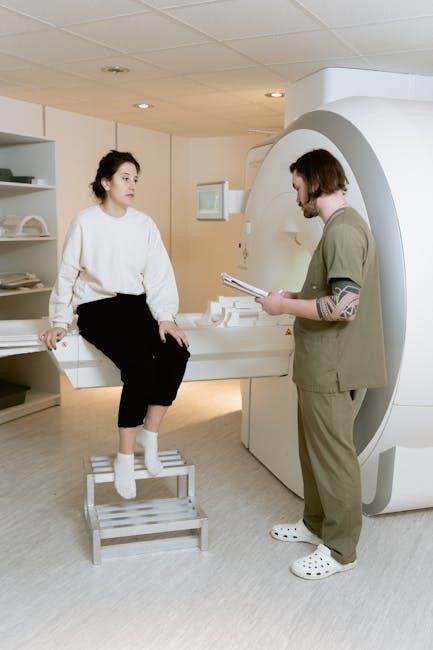The Mann Assessment of Swallowing Ability (MASA), developed by Giselle Mann in 2002, is a clinical tool evaluating swallowing function in patients, primarily used in hospitals and rehabilitation settings to assess 24 key areas for appropriate dietary recommendations.
1.1 Overview of MASA and Its Importance
The Mann Assessment of Swallowing Ability (MASA) is a critical tool for evaluating swallowing function in patients with dysphagia. It provides a comprehensive evaluation of 24 key areas of swallowing ability, enabling clinicians to make informed decisions about dietary recommendations and interventions. MASA is widely used in clinical settings, including hospitals and rehabilitation centers, to assess patients’ ability to safely manage food and fluids. Its importance lies in its ability to identify swallowing impairments, prevent complications like aspiration, and guide tailored treatment plans, ensuring improved patient outcomes and safety.

1.2 Brief History and Development of MASA
The Mann Assessment of Swallowing Ability (MASA) was developed by Giselle Mann in 2002 as a bedside evaluation tool for assessing swallowing function in patients. Designed to address the need for a comprehensive yet practical dysphagia assessment, MASA evaluates 24 key areas of swallowing ability. Its development aimed to provide clinicians with a standardized method to identify impairments and guide appropriate interventions. Since its introduction, MASA has become a widely recognized and validated tool in clinical practice, particularly in hospitals and rehabilitation settings, aiding in the management of patients with swallowing disorders.
Structure and Components of MASA
MASA evaluates 24 specific areas of swallowing ability, providing a comprehensive assessment of a patient’s swallowing function. It is designed for bedside use, ensuring practicality and efficiency in clinical settings.
2.1 Test Description and Scope
The Mann Assessment of Swallowing Ability (MASA) is a comprehensive clinical tool designed for bedside evaluations of swallowing function in patients. Developed by Giselle Mann in 2002, it assesses 24 specific areas of swallowing ability to evaluate oral and pharyngeal phases. The test is widely used in hospitals and rehabilitation settings to guide dietary recommendations and ensure patient safety. Its scope includes evaluating alertness, cooperation, and physiological functions, making it a practical and efficient tool for both initial and follow-up assessments of swallowing disorders.

2.2 Key Assessment Areas (24 Areas of Swallowing Ability)
The Mann Assessment of Swallowing Ability (MASA) evaluates 24 critical areas of swallowing function, including alertness, cooperation, auditory comprehension, and physiological measures. Key areas assessed include oral and pharyngeal phase functions, such as tongue movement, saliva control, and laryngeal elevation. Additionally, it examines the ability to manage fluids and solids, cough effectiveness, and overall swallowing safety. These areas provide a thorough understanding of a patient’s swallowing capabilities, enabling targeted interventions and dietary recommendations to ensure safe and effective nutrition.

Administration of the Mann Assessment
The MASA is administered at the bedside, involving tests like tongue movement, saliva swallow timing, and fluid intake evaluation to ensure accurate swallowing function assessment for dietary planning.
3.1 Preparation for the Test
Preparation for the MASA involves reviewing the scoring sheet and ensuring the patient is alert and cooperative. The speech-language pathologist (SLP) explains the process, ensuring the patient understands instructions. The patient should be seated upright, and water or other test materials should be readily available. The SLP also assesses the patient’s medical history and current condition to tailor the assessment. Documentation of baseline swallowing function and any cognitive impairments is essential for accurate evaluation and appropriate recommendations.
3.2 Step-by-Step Administration Process
The MASA begins with assessing the patient’s alertness and cooperation. The SLP evaluates oral and pharyngeal structures, including tongue movement and palate function. Patients perform tasks like swallowing saliva, water, and food to observe swallowing mechanics. Timing of swallows and respiratory patterns are noted. The SLP also tests voluntary cough and clears the patient’s airway if needed. Each of the 24 assessment areas is systematically evaluated to ensure comprehensive analysis of swallowing ability, following the structured protocol outlined in the MASA scoring sheet.
3.3 Special Considerations for Patients
Patients with severe impairments, such as unconsciousness or acute stroke, require careful monitoring. The SLP should assess their ability to follow commands and ensure safe swallowing. For patients with conditions like COPD, observe respiratory patterns during swallows. Physician-administered screenings may be necessary in critical cases. Monitoring first oral intake is crucial, and consultation with speech pathology is recommended if swallowing difficulties arise. Special attention is given to patients with fluctuating alertness or cooperation, ensuring their safety throughout the assessment process.
Interpreting MASA Results

The MASA scoring system evaluates swallowing ability across 24 areas, with scores indicating normal function, impairment, or severe dysfunction. Cutoff values help identify aspiration risks and pharyngeal phase issues, guiding clinical decisions for patient care and rehabilitation plans.
4.1 Scoring System and Interpretation
The MASA uses a standardized scoring system to evaluate swallowing ability, with scores ranging from 2 to 10 for each of the 24 assessment areas. Higher scores indicate better swallowing function, while lower scores suggest impairment. The total score helps classify swallowing ability, guiding clinical decisions. Specific cutoff values, such as 122 for aspiration and 151 for pharyngeal phase dysfunction, aid in diagnosing swallowing disorders. The scoring system provides a clear framework for interpreting results, enabling healthcare professionals to develop targeted rehabilitation plans and monitor patient progress effectively over time.
4.2 Compiling and Analyzing Test Outcomes
After administering the MASA, the results are compiled by summing scores across the 24 assessment areas. The final score provides a comprehensive view of swallowing ability, aiding in identifying impairments. Analysis involves comparing scores to established norms and monitoring changes over time. Patterns of impairment are noted to guide targeted interventions. Clinicians use these outcomes to develop personalized treatment plans, track progress, and adjust therapies as needed. Regular analysis ensures effective rehabilitation strategies and improves patient outcomes in swallowing function recovery and management.

Clinical Applications of MASA
MASA is widely used in hospitals and rehabilitation settings to assess swallowing disorders, guide dietary recommendations, and monitor progress in patients with dysphagia.
5.1 Use in Hospitals and Rehabilitation Settings
The Mann Assessment of Swallowing Ability (MASA) is primarily utilized in hospitals and rehabilitation centers to evaluate patients with suspected dysphagia; It serves as a bedside tool for clinicians to assess swallowing function, particularly in acute care settings. MASA is often applied to monitor progress in patients undergoing swallowing therapy or rehabilitation. Its application is especially common in cases of stroke, brain injury, or other conditions affecting swallowing ability. The tool helps guide dietary recommendations and ensures safe oral intake, making it indispensable in clinical environments for patient care and recovery.
5.2 Application in Specific Patient Populations
The Mann Assessment of Swallowing Ability (MASA) is widely applied to specific patient populations, particularly those with neurological or structural impairments. It is commonly used for individuals with stroke, brain injury, or progressive conditions like Parkinson’s disease. MASA is also effective for evaluating pediatric and geriatric patients with dysphagia. Its application in these groups helps identify swallowing deficits, monitor progress, and guide tailored interventions. This tool is particularly valuable for patients requiring precise dietary modifications to ensure safe and effective oral intake, enhancing overall patient care and rehabilitation outcomes.

Validity and Reliability of MASA
Research supports MASA’s effectiveness as a reliable bedside assessment tool, with studies confirming its validity in evaluating swallowing disorders and its consistency across diverse patient populations.

6.1 Research on MASA’s Effectiveness
Research highlights the Mann Assessment of Swallowing Ability (MASA) as a reliable tool for evaluating swallowing disorders. Studies confirm its effectiveness in assessing 24 key areas of swallowing function, providing valuable insights for clinical decision-making. MASA has been validated for use in various patient populations, including those with acute stroke, and its sensitivity in detecting aspiration and pharyngeal dysfunction has been demonstrated. This assessment is widely recognized for its ability to monitor swallowing function over time, making it a valuable resource for clinicians in rehabilitation and hospital settings.
6.2 Comparisons with Other Swallowing Assessments
The Mann Assessment of Swallowing Ability (MASA) is frequently compared to other swallowing assessments, such as the modified MASA (mMASA) and the Dysphagia Severity Scale. Unlike some tools, MASA evaluates 24 distinct areas of swallowing ability, offering a comprehensive overview. Studies suggest MASA is as effective as other assessments in identifying dysphagia but is often preferred for its bedside applicability and ease of use. Its structured approach makes it a valuable complement to other clinical tools, enhancing diagnostic accuracy and patient care in diverse clinical settings.

The MASA Scoring Sheet
The MASA Scoring Sheet evaluates 24 areas of swallowing ability, with scores ranging from 2 to 10 for each category. It includes sections like Alertness, Cooperation, and Auditory Comprehension, providing a structured framework for accurate assessment. The sheet is available as a PDF, allowing easy editing and completion by healthcare professionals to ensure precise evaluation and proper patient care.
7.1 Components of the Scoring Sheet
The MASA Scoring Sheet includes 24 assessment areas, such as Alertness, Cooperation, Auditory Comprehension, and Oral and Pharyngeal Function. Each category is scored on a scale, with higher values indicating better ability. Specific tasks, like tongue movement and saliva swallow timing, are evaluated to determine swallowing capability. The sheet also includes sections for clinical observations and recommendations, ensuring comprehensive documentation of a patient’s swallowing function. This structured format allows healthcare professionals to systematically assess and record findings for accurate diagnosis and treatment planning.
7.2 Instructions for Completing the Scoring Sheet
To complete the MASA Scoring Sheet, evaluate each of the 24 areas systematically, assigning scores based on observed swallowing ability. Begin with patient alertness and cooperation, scoring on a scale from 2 to 10. Document oral and pharyngeal function, noting impairments or normal responses. Observe saliva swallow timing and recovery phases, recording abnormalities. Ensure all sections are filled accurately, with comments for clarity. Finally, review and sign the sheet, ensuring consistency and completeness for reliable patient assessment and care planning.
References and Further Reading
Access the MASA PDF and related materials through platforms like Scribd and PrintFriendly. The MASA scoring sheet and user manual are available for free download as PDF files online.
8.1 Recommended Resources for MASA
Key resources for MASA include the official MASA PDF, available on platforms like Scribd and PrintFriendly, which offer free downloads; The MASA scoring sheet and user manual are essential for clinicians. Additional materials, such as research articles and guides, provide in-depth insights into administration and interpretation. These resources are widely accessible and support both clinical practice and academic research, ensuring comprehensive understanding and effective use of the assessment tool.

8.2 Accessing the MASA PDF and Related Materials
The MASA PDF and related materials, such as the scoring sheet, can be easily accessed online through platforms like Scribd and PrintFriendly. These resources are available for free download as PDF or text files. Clinicians and researchers can also find the MASA manual and guides on these platforms. Additionally, tools like PrintFriendly allow users to edit or annotate the PDF for customized use. These materials are widely accessible, making it convenient for professionals to implement MASA in clinical and academic settings effectively.
